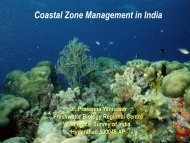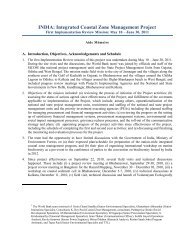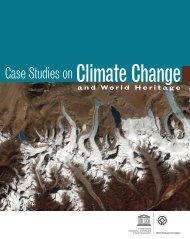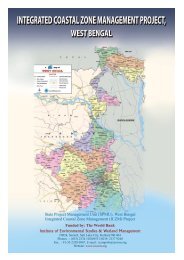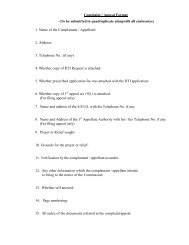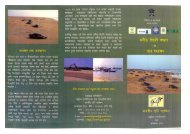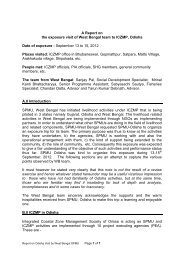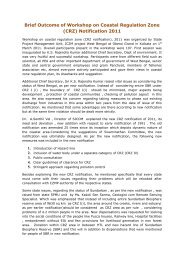Cyclone and Storm Surge - Iczmpwb.org
Cyclone and Storm Surge - Iczmpwb.org
Cyclone and Storm Surge - Iczmpwb.org
You also want an ePaper? Increase the reach of your titles
YUMPU automatically turns print PDFs into web optimized ePapers that Google loves.
6.4<br />
The st<strong>and</strong>ard gradient of the outer slope <strong>and</strong> the inner slope is according to the specifications of the<br />
Irrigation Department: 2 (horizontal): 1 (vertical). For the riverside slope this gradient is most likely a<br />
practical compromise. Steeper gradients reduce the wave run-up but make the slopes more vulnerable<br />
to erosion by wave-dash. Slopes of 2:1 are usually stable if they are properly constructed.<br />
The soils of the embankments at their l<strong>and</strong>sides will gradually become less saline <strong>and</strong> grass will start<br />
to grow on the inner slopes, "promoting" these slopes to grazing grounds for cattle <strong>and</strong> goats. If the<br />
gradient is too steep the cattle will damage the slopes while grazing as can be noticed at many<br />
locations. At a less steep angle the hoofs of the animals act as efficient "compactors", improving the<br />
quality of the embankment, which is important even if it only happens at the inner slope. The gradient<br />
of the l<strong>and</strong>side slope should therefore not be steeper than 2:1 <strong>and</strong> preferably less. After all, the zone<br />
of the inner slope is reasonably productive when used as grazing ground.<br />
In addition to the remarks made about the actual width of the embankments, which have been<br />
visited, needs to be stated that the gradients of the side slopes of nearly all the inspected<br />
embankments are steeper than required by the specifications of the Department. At the riverside this<br />
was sometimes the result of wave-dash which was not yet repaired, but over considerable lengths<br />
the embankments have been constructed with side slopes of 1:1 or even steeper. For all these<br />
reasons the earthen embankments are less stable than they should be <strong>and</strong> could be.<br />
6.2.2. Alignment <strong>and</strong> Berm<br />
Like any other structure made by mankind, an embankment needs to be built on a stable base; if the<br />
foundation fails the structure will be damaged, how solid the structure might have been constructed.<br />
If the base of an embankment is weakened, whatever might be the cause, reinforcement of the<br />
embankment itself will be ineffective.<br />
To guarantee this solid base, the embankment needs to be constructed at a safe distance from the<br />
edge of the river especially if the river banks are not stable <strong>and</strong> show cavings <strong>and</strong> slides.<br />
The zone between the embankment <strong>and</strong> the river, usually indicated as the “outer berm”, is important<br />
for a number of reasons:<br />
• to guarantee the embankment a proper foundation,<br />
• to reduce the velocity of the water flowing close to the embankment during the periods when<br />
the water levels are high,







